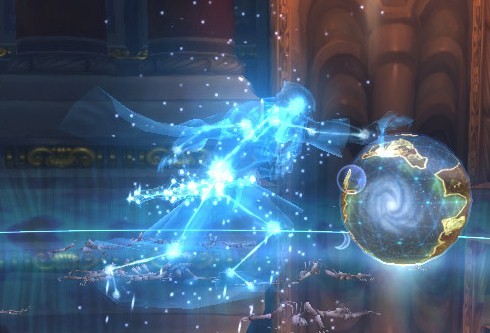
I have seen worlds bathed in the Makers' flames. Their denizens fading without so much as a whimper. Entire planetary systems born and raised in the time that it takes your mortal hearts to beat once... A million, million lives wasted. Had they all held within them your tenacity? Had they all loved life as you do?Algalon's dying breath
Considering the tremendous amount of history contained in the Storm Peaks, it might be worth finding out how Ulduar got there. A history of Azeroth's defense mechanisms follows. It all started during the Ordering...
Parasitic, necrophotic symbiotes
Azeroth was not as peaceful and beautifully formed as it currently is. Before the Titans' arrival, the elements would rage across the world in endless conflict, and the Old Gods would exact chaos upon it.
Naturally, for the Titans to exact order on Azeroth, they would need to eliminate the Old Gods. Unfortunately, it would not be that easy, since the Old Gods were intrinsic to the world. By destroying them, the Titans would also destroy Azeroth. Instead, the Titans settled for imprisoning them deep beneath the surface. In Yogg-Saron's case, a special facility (Ulduar) was constructed especially for her.
The charging of the KeepersBefore leaving Azeroth, the Pantheon (the ruling council of the Titans) appointed several of their kind as Keepers (gaol wardens for Yogg-Saron): Loken, Thorim, Hodir, Freya, Mimir(on) and Tyr. Loken was additionally appointed as prime designate, leading the protection effort of Azeroth.
 The Reckoning.
The Reckoning.Yogg-Saron eventually managed to corrupt Loken (though Loken claims to have wilfully denounced the Titan cause in favor of the Old Gods'). Under the influence, Loken sowed much chaos, including turning Thorim against Hodir's sons. Ultimately, Loken helped Yogg-Saron break free from Ulduar, though this process was delayed by adventurers' slaying him in the Halls of Lightning.
My death... heralds the end of this world.Loken's dying breath
Enter Algalon
 Algalon the Observer, as seen ingame.
Algalon the Observer, as seen ingame.Unfortunately, those adventurers slayed the prime designate, activating the Algalon failsafe. This prompted Algalon the Observer to investigate the situation and submit one of two messages to the Titans:
- Reply-Code Alpha, which indicated that everything was going fine.
- Reply-Code Omega, which indicated that the situation was dire enough to justify a planetary reorigination:
The decomposition of the planet and its living organisms into base elements: metals, rocks, gases. This is followed by a period of reconstitution of each element into the original planetary blueprint.The Archivum Console
Had there been no adventurer intervention, Algalon would have submitted Reply-Code Omega. However, adventurers did interfere. All four sigils from the Keepers (minus Loken and Tyr) were needed to access the Celestial Planetarium, where Algalon was assessing the situation. They obtained them by bashing the influence out of the Keepers, such that each would give their sigil out of (uncorrupted) free will.
To stop Algalon, those adventurers did what they did best (slaying NPCs). This act convinced Algalon that Azeroth was worth preserving (albeit in its imperfect form):
Perhaps it is your imperfection that which grants you free will. That allows you to persevere against cosmically calculated odds. You prevailed where the Titans' own perfect creations have failed.Algalon's dying breath
I've rearranged the reply code. Your planet will be spared. I cannot be certain of my own calculations anymore.
The magical kingdom of Dalaran
Unfortunately, Algalon did not have the required strength to send that message, so the burden fell on the adventurers to find a "place of power close to the skies". Dalaran fitted this description very well, so the message was transmitted from there.
A cataclysm greater than the one more than 10 000 years ago was averted.
EDIT: Appended an epigraph. Appended an explanation of the sigil-collecting process.

No comments:
Post a Comment